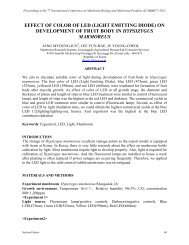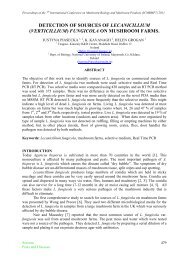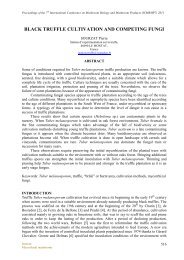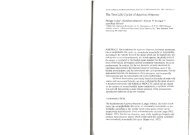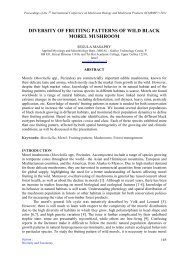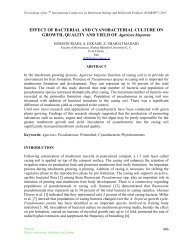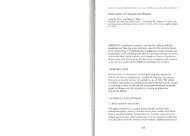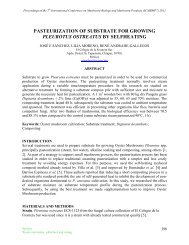Strain improvement of edible fungi with Pleurotus eryngii ...
Strain improvement of edible fungi with Pleurotus eryngii ...
Strain improvement of edible fungi with Pleurotus eryngii ...
Create successful ePaper yourself
Turn your PDF publications into a flip-book with our unique Google optimized e-Paper software.
Proceedings <strong>of</strong> the 7 th International Conference on Mushroom Biology and Mushroom Products (ICMBMP7) 2011<br />
All the hybrids produced <strong>with</strong> P. <strong>eryngii</strong> neohaplont PEC40 produced fruit bodies <strong>with</strong><br />
Lentinula morphology whereas hybrids derived from the other 5 neohaplonts belonging to<br />
mating type II paired <strong>with</strong> L. edodes neohaplont L21-3S resulted in fruit bodies <strong>with</strong> P. <strong>eryngii</strong><br />
morphology. Biological efficiencies <strong>of</strong> hybrids producing fruit bodies <strong>with</strong> Lentinula<br />
morphology after 12 weeks <strong>of</strong> cropping period are shown on Table 2. <strong>Strain</strong> PeC40/ L21-2S<br />
produced the highest biological efficiency, 153%, though other 3 hybrids yielded high BE, 119-124%, in<br />
all cases better BE values than control L. edodes strains, whose BE ranged from 34 to 84%. Fig.<br />
1 shows the fruit bodies produced by control P. <strong>eryngii</strong> dikaryon and two L. edodes strains as<br />
well as 4 different hybrids fruiting <strong>with</strong> Lentinula morphology.<br />
Parental <strong>Strain</strong>s<br />
P. <strong>eryngii</strong> L10 L21<br />
Fruit bodies: large. Pileus:<br />
brown grayish <strong>with</strong> regular<br />
edges. Stipe: white colored,<br />
long and thick<br />
Fruit bodies: large. Pileus: dark<br />
brown, thin, slightly convex <strong>with</strong><br />
scales on edges. Stipe: long and thin<br />
Fruit bodies: medium. Pileus: dark<br />
brown, thick, <strong>with</strong>out scales. Stipe:<br />
thin and very short<br />
Hybrid <strong>Strain</strong>s<br />
PeC40/L21-2S PeC40/ L10-4S PeC40/L10-4S2 PeC40/ L10-1S<br />
Fruit bodies: medium,<br />
large and very large.<br />
Pileus: dark brown, thick,<br />
<strong>with</strong> few scales. Stipe:<br />
beige, long and medium<br />
sized, <strong>with</strong> scales<br />
Fruit bodies: medium,<br />
large and very large.<br />
Pileus: dark brown,<br />
thick, <strong>with</strong> abundant<br />
scales. Stipe: beige<br />
<strong>with</strong> brown spots, long<br />
and thick, <strong>with</strong> scales<br />
Fruit bodies: small,<br />
medium and large. Pileus:<br />
light brown, thick, <strong>with</strong><br />
abundant scales. Stipe:<br />
thick medium sized,<br />
whitish <strong>with</strong> scales<br />
Fruit bodies: small,<br />
medium, large and very<br />
large. Pileus: light brown,<br />
thick, <strong>with</strong> few scales.<br />
Stipe: light brown, long<br />
and thin, <strong>with</strong> few scales<br />
Figure 1: Parental strains and highest producing hybrids <strong>with</strong> L. edodes morphologies<br />
Biological efficiencies <strong>of</strong> the 5 hybrids producing fruit bodies <strong>with</strong> P. <strong>eryngii</strong><br />
morphology are shown on Table 3. Hybrids cultivated on P. <strong>eryngii</strong> substrate had lower<br />
Section:<br />
Genomics, Genetics and Breeding<br />
65



